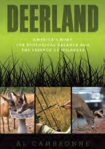SEJournal Online is the digital news magazine of the Society of Environmental Journalists. Learn more about SEJournal Online, including submission, subscription and advertising information.

BookShelf
"Deerland: America’s Hunt for Ecological Balance and the Essence of Wildness"
By Al Cambronne
Lyons Press, $18.95
Reviewer: JENNIFER WEEKS
The most dangerous animal in North America isn’t a great white shark, a bear, or a black widow spider.
It’s Bambi.
Nationwide, the odds that a driver will collide with a deer sometime in the coming year are just more than 1 in 200, or about 0.5 percent, according to State Farm Insurance.
In some states the risk is much higher. About 1.1 million deervehicle crashes in 2012 killed about 150 people and caused more than 10,000 injuries. Sharks, by comparison, killed three people in the United States from 2006 through 2010.
In “Deerland,” freelancer writer and SEJ member Al Cambronne explains how deer have become so abundant, and explores the weird relationship between Americans and deer.
Cambronne, an occasional hunter who lives in Wisconsin, makes a strong case that hunting is probably the best tool we have to keep the deer population explosion at least somewhat under control.
Deer have been in North America for millions of years, but were nearly hunted out of existence in many areas by the early 1900s.
Since then, the U.S. deer population has grown by a factor of 100, to some 30 million today. That’s due largely to human actions. We have removed large predators such as wolves that once kept deer numbers in check, and suburban development has created millions of acres of ideal deer habitat – large lots with abundant “edge zones” where lawns meet woods.
Deer are well-adapted to take advantage of these conditions. They can run up to 36 miles per hour, jump eight-foot fences, and move quickly through thick woods. They’re also good swimmers. Deer have extremely good hearing, vision and sense of smell, so they can detect food, water and danger from far away.
These traits also make them interesting to hunt, and much of “Deerland” is a detailed and entertaining tour through the modern deer-hunting industry.
As Cambronne explains, hunting is big business: Only 6 percent of adults in the United States hunt, but they spent $34 billion on gear, licenses and other items in 2011. Up to 80 percent of those expenses were for deer hunting. If deer hunting was a single corporation, its $17 billion in revenues would rank it 154th on the Fortune 500.
Cambronne introduces readers to many different kinds of hunters. Some are “deer farmers,” wealthy CEOs who live in Milwaukee or Chicago, but own large tracts of rural Midwestern land for weekend hunting. They want to bag bucks with big antlers, and they buy a lot of gear, including handheld GPS receivers; motionsensing digital cameras to monitor their hunting spots; and farm equipment to grow grain that will attract deer to their property.
More commonly, though, hunters live in small towns and rural areas, own one rifle, and are in it for the meat.
One Wisconsin state trooper tells Cambronne that he carries a list of people he knows who are out of work or struggling financially, and might want to take home a road-kill deer (which often are surprisingly intact). For many Americans, venison is “a regular staple that stretches their modest incomes a lot farther at the grocery store,” Cambronne writes.
“Deerland” does not gloss over ethical questions about hunting, such as whether it’s acceptable to set out bait for prey. But Cambronne also argues that wildlife lovers who feed deer don’t do the animals any favors. Corn causes digestive problems that can kill deer who are unaccustomed to eating it.
Feeding deer also draws them out of winter dens into subzero weather. And it lures them into developed areas, where they are likely to stick around and munch on garden shrubs. “They come for the corn and stay for the salad,” a county forester tells Cambronne.
There are few good options for suburbs that are already overridden with deer. Trap-and-relocate programs are expensive, and animal contraception only works on very small populations in isolated areas where animals are easy to reach and treat.
Cambronne talks to homeowners and hunters in Duluth, where a managed bowhunting program is removing hundreds of deer annually from hilly neighborhoods. By his account, most residents seem to accept the idea.
“I’ve seen a few deer killed,” one woman tells him. “I don’t like to see it, but you know, I don’t like to see them killed on the street [by cars] either.”
Cambronne predicts that we will need hunters for the foreseeable future to reduce or at least maintain deer populations. One option would be to restore commercial deer harvesting – i.e., let hunters sell deer meat.
Australia has legalized market hunting for kangaroos to curb an overpopulation problem. Cambronne acknowledges that would be controversial in the United States (as it is in Australia).
Perhaps it would be progress if more Americans understood that a landscape teeming with deer is not a healthy ecosystem.
Jennifer Weeks is a Boston-based freelancer and a member of SEJ’s board of directors.
* From the quarterly newsletter SEJournal, Fall 2013. Each new issue of SEJournal is available to members and subscribers only; find subscription information here or learn how to join SEJ. Past issues are archived for the public here.












 Advertisement
Advertisement 



